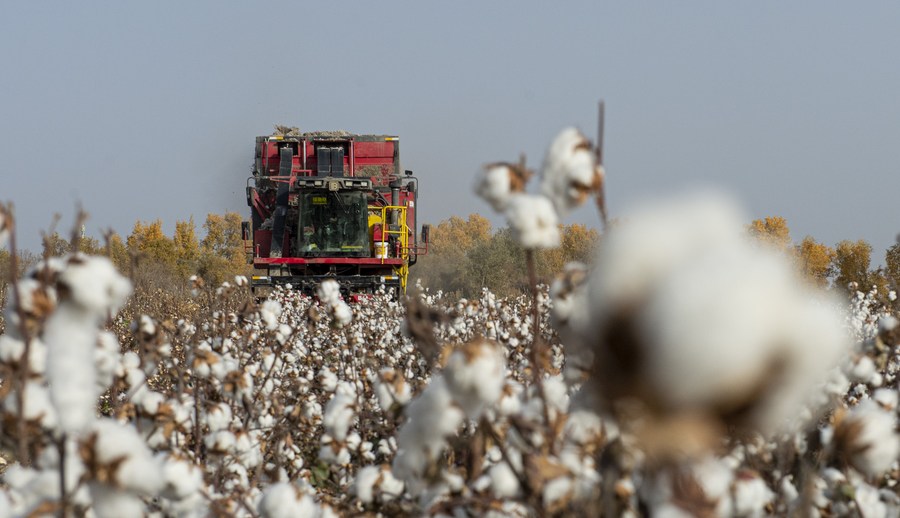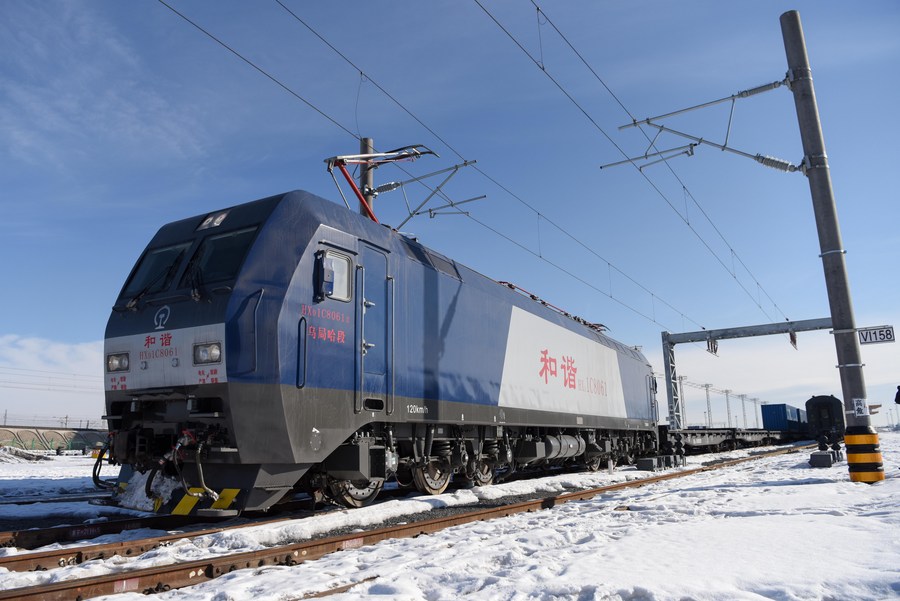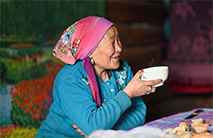Xinjiang enjoys good governance featuring development, stability and opening up
-- Northwest China's Xinjiang Uygur Autonomous Region has seen continuous economic development with businesses thriving. People's livelihood has also been boosted with higher disposable incomes across the region.
-- Xinjiang registered a 7-percent GDP growth in 2021, totalling 1.6 trillion yuan (about 253.2 billion U.S. dollars). A total of 477,400 urban jobs were created in the region, reducing the surveyed urban unemployment rate by 1.1 percentage points to 2.2 percent.
-- In 2021, Xinjiang continued to increase spending on people's livelihood, with an expenditure of 398.23 billion yuan, accounting for 73.7 percent of the general public budget expenditure.
URUMQI, Feb. 3 (Xinhua) -- People of all ethnic groups in China's Xinjiang are leading a happy life thanks to good governance featuring development, stability and opening up.
Especially over the past five years, people in the region are no longer disturbed by terrorism as Xinjiang has been free of terrorist incidents for five consecutive years.
Thanks to the counterterrorism measures in Xinjiang, the region has achieved social stability and people of all ethnic groups in Xinjiang have a growing sense of security and fulfillment.
Along with the opening up drive, the economic growth has been sustained and public well-being has been continuously improved in Xinjiang. According to the work report of the regional government released last month, Xinjiang registered a 7-percent GDP growth in 2021, totaling nearly 1.6 trillion yuan (about 251.2 billion U.S. dollars).

A cotton picker is seen in a cotton field in Gezkum Town of Xayar County, Aksu Prefecture, northwest China's Xinjiang Uygur Autonomous Region, Oct. 25, 2021. (Xinhua/Ma Kai)
INDUSTRIES DEVELOPING RAPIDLY
Xinjiang put an end to absolute poverty in the region by the end of 2020. People in the region have access to stable income and public services due to the region's anti-poverty efforts. Various industries have been developing rapidly.
The cotton industry -- a main industry in Xinjiang -- provides an important way for a large number of local farmers to increase their income.
At present, Xinjiang has formed a cotton industry system integrating cotton production, service, circulation, processing and sales. In 2021, the total cotton output in Xinjiang reached 5.13 million tonnes, accounting for 89.5 percent of that in the country. The mechanical harvesting rate reached 80 percent.
"Xinjiang's cotton industry is in the transitional stage from resource advantage to economic development advantage," said Song Lin, chairman of Xinjiang Beidacang Agricultural Science and Technology Development Co., Ltd.
According to the government work report, Xinjiang will stabilize supply of high-quality commercial cotton at a level of over 5 million tonnes this year.
Besides the cotton industry, industries of agriculture, animal husbandry, textile, wine, and petrochemicals have also been developing fast.
In the future, Xinjiang will actively develop industries such as new materials, high-end equipment manufacturing, biotechnology, new energy, new-generation information technology, and energy conservation.
Xinjiang will also increase the coverage and application of 5G networks, deeply integrate the Internet, big data and artificial intelligence with economic and social development, and promote industrial digitization.
OPENING-UP DRIVEN BY BELT AND ROAD
"Our village has converted the management right of 100 hectares of grassland into shares, and 395 herders have become shareholders of an economic cooperative," said Anar Balatibek, head of Kalasu Village.
The local government implemented reform measures to make "pastures become equity, villagers become investors, and everyone gets dividends."
The development measure in Kalasu Village is just an example of Xinjiang's deepening reform and opening-up policies in recent years.

A China-Europe freight train, loaded with walnuts for export to Turkey, pulls out of the Urumqi China-Europe Railway Express Hub in Urumqi, capital of northwest China's Xinjiang Uygur Autonomous Region, Feb. 20, 2020. (Xinhua/Ding Lei)
"A better business environment has given us confidence and motivation," said Abduvpur Abdugul, deputy general manager of a Urumqi-based trading company, adding that establishing a good business environment is necessary for enterprise development.
For the past few years, Xinjiang has taken proactive measures to build itself as a core area of the Silk Road Economic Belt and made progress. Xinjiang has opened its door wider to the outside world under the Belt and Road Initiative (BRI), with related cooperation deals covering more than 50 countries and regions, regional authorities said.
The region has become an important channel for exchanges between countries along the BRI and an important gateway for China to open up to the West and foster opening-up on all fronts.
In 2021, Horgos Port and Alataw Pass, both major rail ports in Xinjiang, handled a total of 12,210 freight trains connecting China with European and Central Asian countries, up 21.5 percent compared to 2020.
Besides the launch of new freight trains to Central Asia, the prefecture of Kashgar in southern Xinjiang opened four new international air cargo routes in January in its efforts to further opening up, according to local authorities.
Last year, the total foreign trade of Kashgar reached 23.12 billion yuan, up 89.7 percent year on year.
"We will continue to optimize the business environment, advance the reform of customs operations, take advantage of the China-Europe freight train service to promote the exports of Kashgar's specialty agricultural products as well as clothing and textile products, to actively promote the high-quality development of local open economy," said Wang Chuanjie, head of Kashgar Customs.
PUBLIC WELLBEING IMPROVED
Buasi Maimati, a villager in Pishan County, is satisfied with the government's efforts to improve medical services.
"I had an operation to treat intestinal obstruction, and I only paid a few hundred yuan. The rest was reimbursed by the government, which greatly relieved the pressure of seeing a doctor," she said.

Children have fun in "Dove Lane" in the old town Tuancheng of Hotan City, northwest China's Xinjiang Uygur Autonomous Region, May 27, 2020. (Xinhua/Shadati)
According to statistics of the regional health department, medical institutions have been set up in every town and village in Xinjiang.
In 2021, Xinjiang continued to increase investment in people's well-being, with an expenditure of 398.23 billion yuan, accounting for 73.7 percent of the general public budget expenditure.
According to the regional government, Xinjiang will implement a series of preferential policies in employment, education, and health to accelerate the improvement of people's well-being and continuously improve people's quality of life.
Photos
Related Stories
- Xinjiang's Kashgar opens 4 new int'l air cargo routes
- Herdsmen in Xinjiang live better life
- Xinjiang's Zhaosu improves living conditions in Akyaz valley for herdsmen
- Xinjiang to open first plateau airport
- Profile: Xinjiang skier nurturing next generation of sporting excellence
- Xinjiang expands loans to boost high-quality development of agriculture
Copyright © 2022 People's Daily Online. All Rights Reserved.










